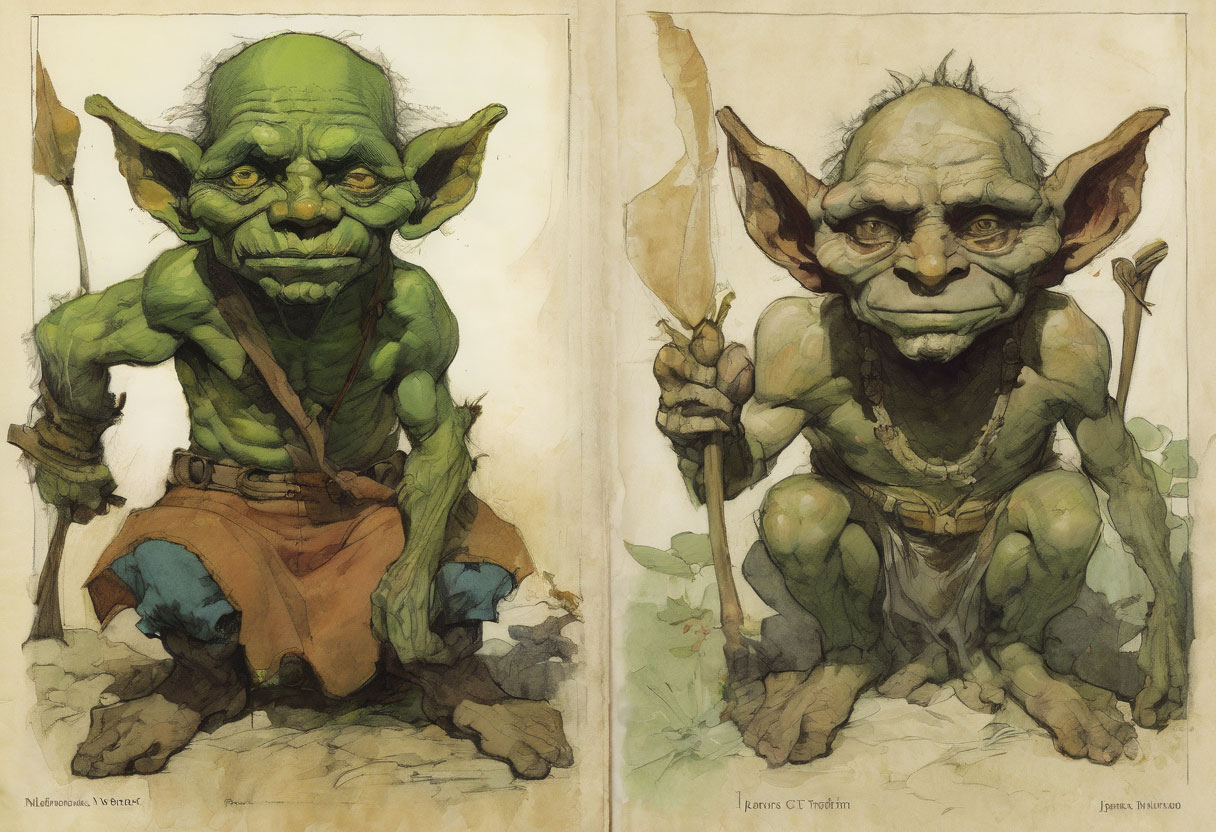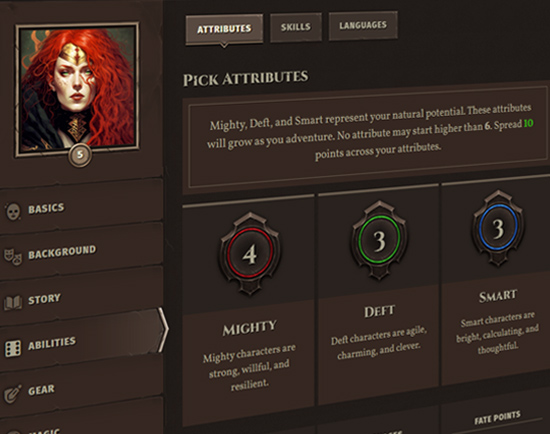While the official Game Master’s guide for OSR+ is in the works, I give you NPC shorthand, an essential tool for GMs to reference NPC stats while running encounters in the game. All NPCs, be they monsters or human bandits, should fit on the size of an index card.
One of the concerns I had when designing OSR+ is the amount of work a GM has to do to prepare for a session. I didn't want to spend hours in prep, and I wanted designing encounters to be as fun as playing. During playtesting, I quickly developed a shorthand to write down NPC stats in as small a space as possible.
Prep & Nodes
Most of the time, when I write the material for an adventure, I actually write the material for several sessions all at once, without realizing it. This is because my approach to writing adventures follows node-based scenario design, as originally outlined by Justin Alexander over at The Alexandrian.
In short, this approach to designing adventures sets up a series of "nodes" that your PCs can adventure through in any order, with each node giving clues to explore other nodes until the whole shebang reaches a natural conclusion. Because your players can approach things in any order, you often can't know exactly how far they'll get in any given session. As a result, I end up with a number of pages that describe all my nodes: usually a half a page to a page of text per node, mostly in bullet points.

I bring this up because when you write a bunch of nodes like this, your packet ends up requiring a lot of NPC stats. Some of those nodes may be combat encounters. And since you can't really know where your players might end up in a given session as they bounce around from node to node, that means you can't know exactly which NPC's stats you'll need. So you have to prepare them all at the outset.
In trad games where NPC stats can be as long as PC stats, this creates a huge pile of GM prep that you have to suffer through.
Thankfully, OSR+ makes writing down your NPC stats super easy—barely an inconvenience!
Example NPC Cards
Introducing: NPC shorthand. Below you'll see an example of a "Yum Yum Goblin." These little jerks were discovered by my players in the adventure Fiskhollow Winter is a mini-campaign involving lost civilizations and Indiana Jones-style adventure. Fiskhollow Winter (set in the campaign setting The Long Night is a campaign setting (of which Fiskhollow Winter is a part) that is slated to be released in the future. Both have fully recorded actual plays, so you can watch along as the adventure unfolds. The Long Night ), I have been told I subconsciously stole these guys from the movie Gremlins, and that's entirely possible because I was like 6 years old when the sequel came out.
Redmainer Hunter
Human Ranger (L: 1 Monster Hunter)
M: 4, D: 4, S: 3
HP: 5/10, DEF: +6, MP: 8
(Shell Armor, Body Shield)
(Stealth : Attack)
Skills: Survival +6, W: Edged +6
- Create Monster Hunting Supply (2 MP)
- Always Has Cheap Supply
- Wilderness Tracking/Stealth (A)
- Longsword +6: 5 (Defender)
Time Mage
High Person Mage (L: 5 Chronomancer)
M: 1 (D), D: 3, S: 8 (A)
HP: 4/6, DEF: +6, MP: 14
(Dimensional Robes)
(Spell || Maleficence)
Skills: Domain: Statecraft +10 (A), Influence +10 (D), Lore +5, Perception +5, Sorcery +10 (A)
- Acts on Any Turn (Chronomancer)
- Counterspell (Mage)
- Permanent Duo-Dimension (Dimensional Robes)
- Bonus Parry (Energy Scepter)
- Maleficence +10 (A): d6 (Chaos)
- Energy Scepter +10 (A): 0 (Fire, Redirect)
Spells +10: Antimagic Whip, Chain Maleficence, Elemental Form, Fly, Haste & Slow, Heal, Spell Turning
Ghoul (L: 4 Undead)
M: 1, D: 4, S: 1
HP: 2, DEF: +6
(Unarmed || Bite)
- +2 Initiative
- Infravision
- Immune to Poison, Cold, Charm, Sleep, Fear
- +1 to Unarmed Per Ghoul in Melee
- Bite +6: 1 Wound
- Unarmed +1: 2 (Entangle)
Dissecting the NPC Card
NPC shorthand is designed to make it easy to glean what the NPC can do without flipping any pages or looking anything up.* As a GM, you already know what tactics do (there aren't that many), and you already know the basic perils and their secondary effects in the system, so references to "Reach" or "Lightning" should be enough to jog your memory. (And if they're not, just peek at your handy GM Cheatsheet).
Here's how it all breaks down line-by-line:
Name, Level, Origin, Class, Kit
For monsters, we just need to know their monster type (Humanoid) and their level. For non-monstrous NPCs, we need to know their level, plus their origin, class, and kit.
Attributes
Mighty, Deft, and Smart. We write (A) or (D) if an attribute has advantage or disadvantage.
HP/AP, Defense, MP, and SOak
HP and AP are written as a pair: 5/10, and Defense as a bonus. Soak (not depicted above) is a flat number between 1 - 3.
Armor Type, Shields
This is an optional line to detail the sort of armor they're wearing and if they carry a shield. More of a reminder of the fiction, that way you can better describe them during the encounter.
SKills
We list all known skills and their modified rolls here.
Abilities
The bulleted list here encompasses anything the NPC can do that is not an attack, including passive abilities they may have ("Immune to Fire") or abilities from kits and classes. I also put villainous actions here for BBEGs.
Attacks/Maleficence
Each unique attack is underlined, so it sticks out visually. The pattern is Weapon Name [To Hit]: Damage (Tactics, Perils). I like to name the style of weapon (as opposed to its class, so "Spear" vs. "Reach"), but avoid ambiguity ("Thrown Dagger" vs. "Dagger": this distinguishes between a Thrown vs. Small weapon).
Spells
Finally, spellcasters simply list their spells. Some spells I underline, to indicate to me that the NPC comes into play with that spell already cast. You will need to look up spells, I admit, but they're always a single paragraph and you can search for them directly on this website. This is the one thing you'd need to look up! But luckily for you, all spells in OSR+ are no more than a paragraph long.

Writing for Brevity
We want to make sure that everything on the card helps you be as lazy as possible at game time.
- The numbers are all pre-calculated by you when you write up the card, that way you don't have to do any math on the fly: just roll and add the bonus indicated. For example, we decided that the Yum Yum Goblin is skilled at Spears, so we wrote down +3 to his attack (his Mighty of 1, +2 for being skilled with the weapon). He's not skilled at throwing Firebombs or using the Sling, so the +3 here reflects his Deft alone. Similarly, perks from level advancement are already factored into the final numbers.
- We're also careful to refer to abilities in ways that are obvious what they are: with the Redmainer Hunter, instead of "Resourceful" (which is the class ability that the Ranger has), we write "Always Has Cheap Supply" because that makes it obvious on its face what the ability does.
Strategy Notation
Strategy notation borrows syntax from programming (the conditional operator) to minimize the amount of language necessary to describe the NPC's behavioral pattern. A colon : means "then," whereas a double-pound || means "or." Finally the ? means "if." This is to remind you what the NPC would do if threatened, or any special things it might do as its status changes.
Some examples:
- Bloodied ? Earthquake : Club x2. If at half health, the giant uses its legendary Earthquake ability, otherwise it just attacks twice with a club.
- Darts x2 || Smoke Bomb. The NPC makes two thrown attacks, or uses a smoke bomb.
- Stealth : Attack. Go into stealth, then attack.
Monster Maker & the Future
One of things we're working on for OSR+ is a Monster Maker, which would be a tool very similar to the Character Creator that lets you create custom NPCs from a bank of abilities. In the short term, we intend to release a library of monsters from each campaign setting, to serve as a baseline compendium for use in your games. But it's not hard to whip together a monster in OSR+ on pen and paper, as you can see.
In the meantime, keep an eye out for a future post that describes how we calculate a monster's level to assess the sort of threat it poses to your heroes.
 Armor
Armor Classes
Classes Conflicts
Conflicts Ethos
Ethos Flaws
Flaws Kits
Kits Maleficence
Maleficence Origins
Origins Shields
Shields Skills
Skills Spells
Spells Stances
Stances Tactics
Tactics Talents
Talents Treasure
Treasure Weapons
Weapons











 Hall of Heroes
Hall of Heroes Hall of Legends
Hall of Legends Dungeons & Flagons
Dungeons & Flagons
0 Comments on
NPC Shorthand for Encounters